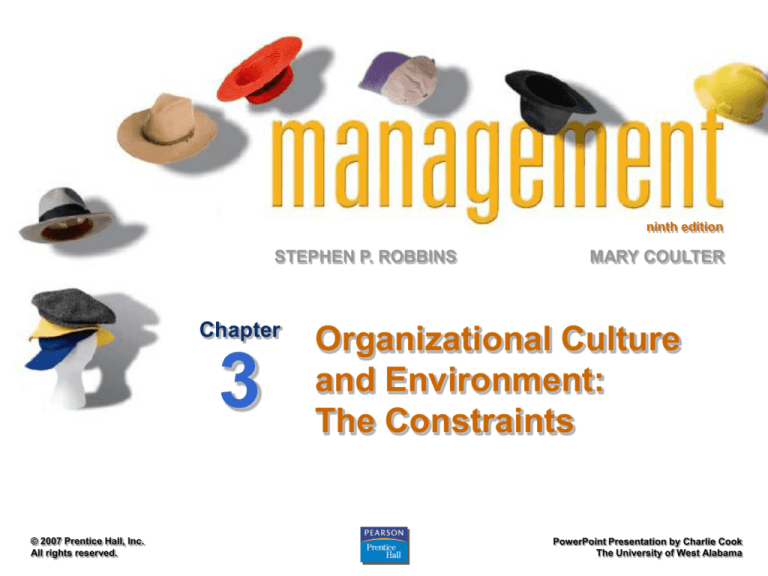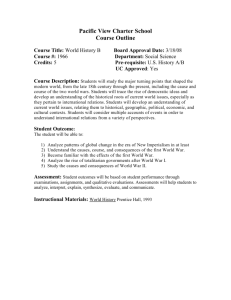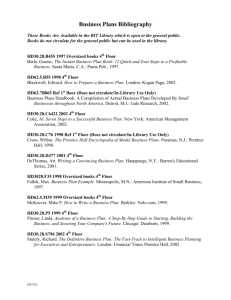
ninth edition
STEPHEN P. ROBBINS
Chapter
3
© 2007 Prentice Hall, Inc.
All rights reserved.
MARY COULTER
Organizational Culture
and Environment:
The Constraints
PowerPoint Presentation by Charlie Cook
The University of West Alabama
A Question of Culture . . .
Q: What makes up the culture of a
country?
© 2007 Prentice Hall, Inc. All rights reserved.
3–2
The Organization’s Culture
• Organizational Culture
A system of shared meanings and common beliefs
held by organizational members that determines, in a
large degree, how they act towards each other.
“The way we do things around here.”
Values, symbols, rituals, and practices
Implications:
Culture is a perception.
Culture is shared.
Culture is descriptive.
© 2007 Prentice Hall, Inc. All rights reserved.
3–3
Exhibit 3–2 Dimensions of Organizational Culture
© 2007 Prentice Hall, Inc. All rights reserved.
3–4
Exhibit 3–4 Strong versus Weak Organizational Cultures
© 2007 Prentice Hall, Inc. All rights reserved.
3–5
Benefits of a Strong Culture
• Creates a stronger employee commitment to the
organization.
• Aids in the recruitment and socialization of new
employees.
• Fosters higher organizational
performance by instilling and
promoting employee initiative.
© 2007 Prentice Hall, Inc. All rights reserved.
3–6
Functional versus Dysfunctional
Cultures
• Functional Cultures
Are cultures well-suited to their environment or industry.
Ex: A highly-innovative company in the high-tech industry, or a
customer-focused company in the high-end lodging industry.
• Dysfunctional Cultures
Are cultures which are poorly-suited to their
environment.
Ex: A company which is slow to react to marketplace changes,
or a company which has low concern for employees or
customers.
© 2007 Prentice Hall, Inc. All rights reserved.
3–7
Organizational Culture
• Sources of Organizational Culture
The organization’s founder
Vision and mission
Past practices of the organization
The way things have been done
The behavior of top management
• Continuation of the Organizational Culture
Recruitment of like-minded employees who “fit”
Socialization of new employees to help them adapt
to the culture
© 2007 Prentice Hall, Inc. All rights reserved.
3–8
How Employees Learn Culture
• Stories
Narratives of significant events or actions of people that convey
the spirit of the organization
• Rituals
Repetitive sequences of activities that express and reinforce the
values of the organization
• Material Symbols
Physical assets distinguishing the organization
• Language
Acronyms and jargon of terms, phrases, and word meanings
specific to an organization
© 2007 Prentice Hall, Inc. All rights reserved.
3–9
Exhibit 3–5 How an Organization’s Culture Is Established
and Maintained
© 2007 Prentice Hall, Inc. All rights reserved.
3–10
Exhibit 3–7 Suggestions for Managers: Creating a More Ethical Culture
• Be a visible role model.
• Communicate ethical expectations.
• Provide ethics training.
• Visibly reward ethical acts and punish unethical
ones.
• Provide protective mechanisms so employees can
discuss ethical dilemmas and report unethical
behavior without fear.
© 2007 Prentice Hall, Inc. All rights reserved.
3–11
Exhibit 3–8 Suggestions for Managers: Creating a More CustomerResponsive Culture
• Hire service-contact people with the personality and attitudes
consistent with customer service—friendliness, enthusiasm,
attentiveness, patience, concern about others, and listening skills.
• Train customer service people continuously by focusing on
improving product knowledge, active listening, showing patience,
and displaying emotions.
• Socialize new service-contact people to the organization’s goals and
values.
• Design customer-service jobs so that employees have as much
control as necessary to satisfy customers.
• Empower service-contact employees with the discretion to make
day-to-day decisions on job-related activities.
• As the leader, convey a customer-focused vision and demonstrate
through decisions and actions the commitment to customers.
© 2007 Prentice Hall, Inc. All rights reserved.
3–12
Spirituality and Organizational Culture
•Workplace Spirituality
The recognition that people have an inner life that
nourishes and is nourished by meaningful work that
takes place in the context of community.
•Characteristics of a Spiritual Organization
Strong sense of purpose
Focus on individual development
Trust and openness
Employee empowerment
Toleration of employees’ expression
© 2007 Prentice Hall, Inc. All rights reserved.
3–13
Benefits of Spirituality
• Improved employee productivity
• Reduction of employee turnover
• Stronger organizational performance
• Increased creativity
• Increased employee satisfaction
• Increased team performance
• Increased organizational performance
© 2007 Prentice Hall, Inc. All rights reserved.
3–14
Exhibit 3–9 The External Environment
© 2007 Prentice Hall, Inc. All rights reserved.
3–15
How the Environment Affects Managers
• Environmental Uncertainty
The extent to which managers have knowledge of
and are able to predict change their organization’s
external environment is affected by:
Complexity of the environment: the number of components
in an organization’s external environment.
Degree of change in environmental components: how
dynamic or stable the external environment is.
© 2007 Prentice Hall, Inc. All rights reserved.
3–16
Competitors
• Competitive Intelligence (CI)
• Fuld & Company (www.fuld.com)
© 2007 Prentice Hall, Inc. All rights reserved.
3–17
Exhibit 3–12 Organizational Stakeholders
© 2007 Prentice Hall, Inc. All rights reserved.
3–18
ninth edition
STEPHEN P. ROBBINS
MARY COULTER
THANK YOU FOR YOUR
PARTICIPARTION
© 2007 Prentice Hall, Inc.
All rights reserved.
PowerPoint Presentation by Charlie Cook
The University of West Alabama







